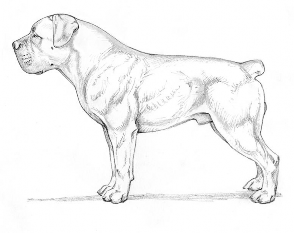
The Body

The body is approximately 15% longer than the height and is measured horizontally, from the point of the shoulder to a vertical line at the rear of the rump.
A 15% longer body, compared to the height at the withers, gives the side view of the Boerboel a blocky profile, as opposed to a square one like the Bullmastiff. When describing the body of a dog in a breed standard, most things like ratios are approximate, because there are so many variations that can be effective. So, it is acceptable if a dog is a bit longer, or a bit shorter than the desired length. The main thing is that the length is not so short that the dog is square like a Bullmastiff, or shorter in the body than the height like a Boxer, or too long in body like a Neapolitan Mastiff. (The length of the chest, loin and rump is approximately proportioned 2:1:1).
Here we are describing the rib cage, from the back of the shoulders, to where the loin starts (not where the ribs finish), to the end of the loin and the rump portion. This is the back of the dog, also called the topline.
It is blocky, muscular, solid and has good depth and width.
Once again the term blocky is used. Many Boerboels have good depth, but many lack width. It is hard to get a blocky appearance without width. Solid is a suggestion of movement and construction. A dog that has a swaying back when moving and is soft and sloppy in the body is the opposite of solid.
A blocky build also creates a dog that is more explosive over short distances rather than a dog that is tall which will have a faster top speed and a lanky type of gate.
The back is broad and straight, with pronounced muscles that form an imperceptible arch in the top line over the lumber region.
When looking from the side, the topline should be straight and almost parallel with the ground. The imperceptible arch described in the standard is like the top of the arch that is almost flat, but you know there is a curve to it. So it is with the top line of the Boerboel’s back, it should have a very slight curve to it, over the lumber or loin region. This is the part of the dog’s body that has only a spine as the structural skeleton.
The spine is made up of many separate pieces. When all the muscle is taken away, the portion of the spine, in-between the ribs and the hips should look like a small arch that is spanning across two points. If you know anything about engineering, you know that when you are using many individual pieces (like a spine has many pieces to it) to create a bridge, the arch is the strongest shape because it interlocks the pieces together and the weight of the bridge locks everything in onto itself.
When looking from above the dog, the back is still straight and symmetrical. It is broad with distinct muscles on the loin region and at the withers. There should be a definite partition between the left side and the right side loin muscles.
The brisket reaches down to the point of the elbow, which is approximately half the total height at the withers.
This is a great reference point to check if a dogs front end construction is correct. So if the shoulder angulation is correct, and the depth of chest is correct, they should both line up at the same point when looking from the side. If they don’t line up, then you need to ask yourself the question, “Is it because the shoulders are too straight or is it because the chest is too shallow?”
The transitions between the chest, loin and rump are well filled and flowing.
If it is not flowing and pleasant to the eye, there is probably something wrong.
